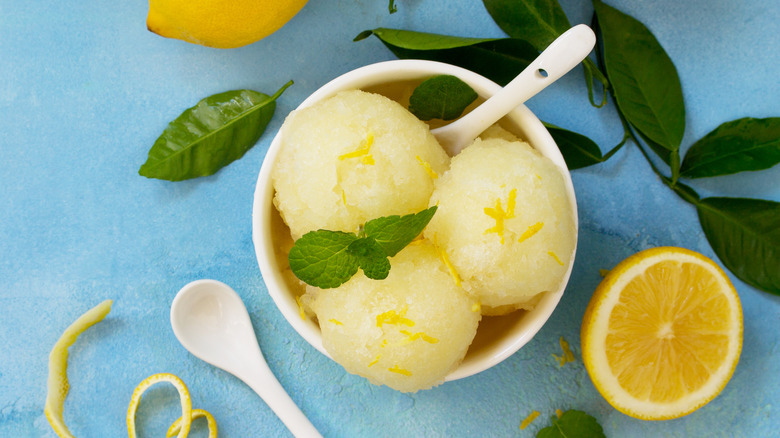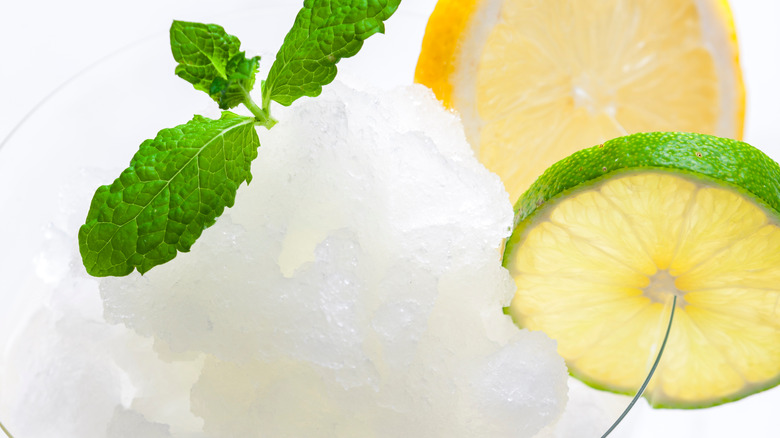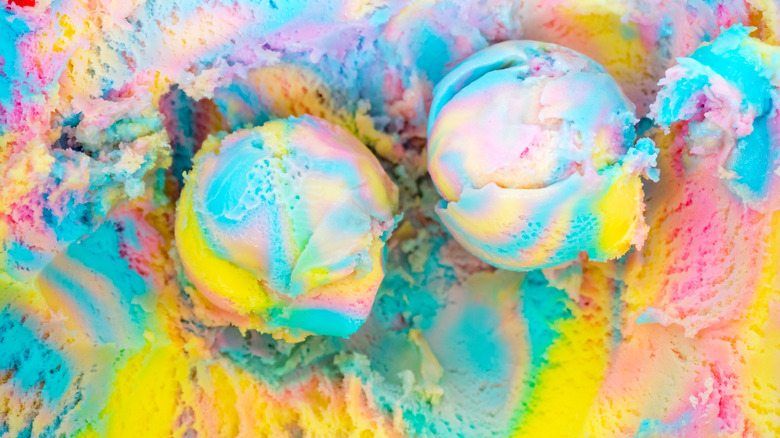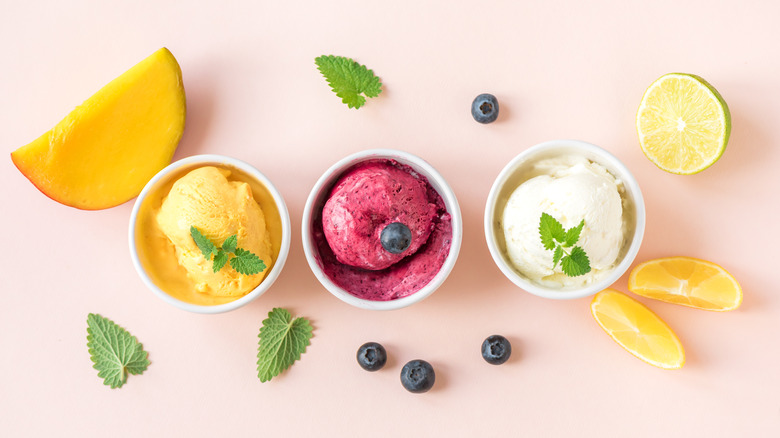The Untold Truth Of Sorbet
Who doesn't like a cold bowlful of sweet, fruity goodness on a hot summer day — or even a frigid winter night, for that matter? Sorbet offers just that!
In fact, the word "sorbet" derives from Arabic and fittingly translates to "sweet snow" (via Seconds Food History). This classic treat is an elegant, delicious frozen dessert that's been enjoyed all over the world for centuries, according to Jolly Llama. It has a sweet, tangy, and refreshing taste and — similar to its super chill cousins ice cream, gelato, frozen yogurt, sherbet, Italian ice, and granita — it comes in a massive variety of flavors. The different flavors are achieved naturally by using fresh fruit, all of which alter the dessert's texture and taste accordingly.
Sorbet also comes with a fascinating history, with plenty of stories and myths surrounding it. In fact, many sources disagree on the exact origin of sorbet, adding even more mystery to this seemingly simple dessert.
The origin of sorbet is up for debate
There are a few recognized stories of how sorbet was invented, and many of them date back to ancient Rome (via Jolly Llama). One account claims that sorbet was invented by Roman Emperor Nero, who would request his slaves to fetch buckets of snow from mountains, which would then be sweetened with honey and wine for him to enjoy.
Seconds Food History claims that some have also linked sorbet to the medieval Arabic world when people used to drink ice-cold beverages flavored with cherries, pomegranates, rose water, and orange blossom. The source says that these drinks are thought to have inspired Europeans to create their own variation, which later became popular among aristocrats.
Another often-told story, says Seconds Food History, is that of Antonio Latini — an Italian man who worked for a Spanish governor in Naples. He is believed to be the first person to record the recipe for sorbetto, which was included in his cookbook "Lo Scalco alla Moderna." Latini's sorbet recipes included lemon, cinnamon, strawberry, cherry, pine nut, and ... aubergines. (Yum?)
Sorbet is not the same as sherbet
Sorbet and sherbet are commonly mistaken for one another, with many people using the terms interchangeably. However, there's a key difference between the two desserts — milk.
Vegans and those who are lactose intolerant can usually enjoy all the sorbet their heart desires because it normally contains no dairy or animal by-products — unlike sherbet. According to Reader's Digest, sorbet is a blend of water, fruit juice or puree, sweeteners (such as sugar, honey, agave, or sugar substitutes like Stevia), and other flavor-enhancing ingredients such as herbs and spices. Sorbet also has a light, icy texture and is commonly eaten as a palate cleanser between courses (via MasterClass).
Sherbet, on the other hand, contains milk, cream, or butter — and sometimes gelatin or egg whites — to give it a smoother, creamier consistency. As a matter of fact, according to the U.S. Food and Drug Administration, sherbet, by definition, can have up to 2% milkfat.
Sorbet became a hit thanks to a modern appliance
Sorbet hasn't always been easily accessible. The refrigerator as we know it is actually a fairly recent invention and is an appliance that we perhaps take for granted when it comes to safe, prolonged food storage. The domestic refrigerator was invented in 1913 by Fred W. Wolf of Fort Wayne, Indiana. Then in 1914, Nathaniel B. Wales of Detroit, Michigan introduced a refrigeration unit that functioned with electricity (via History of Refrigeration).
Before this time, sorbet was quite costly because of the age-old economic principle of supply and demand — many people craved sorbet, but there wasn't enough of it. Without reliable refrigeration, sorbets and other items that required cooling for longevity and preservation (like vegetables and meat products) melted or spoiled easily. The appliance became widespread and appeared in many American homes throughout the 1920s and 1930s, making sorbet more affordable and readily available to families. This also allowed for more grocery stores and vendors to carry and sell the treat at a reasonable price (via Jolly Llama).
Sorbet contains more sugar than ice cream
It's a common assumption that just because sorbet contains fruit juice and has no dairy, it automatically makes it healthier than ice cream or other frozen treats. In reality, a serving of sorbet typically contains way more sugar than your average scoop of ice cream, reports Spoon University. According to Organic.org, one cup of sorbet contains around 184 calories, 34 grams of sugar, 46 grams of carbohydrates, and zero grams of fat, whereas a cup of vanilla bean gelato contains 204 calories, 9 grams of fat, 25 grams of sugar, and 25 grams of carbohydrates.
Serious Eats explains that sorbet is basically the syrup that is produced when sugar dissolves in water. This product has a lower freezing point than plain water — the sweeter the syrup, the lower the freezing point. Of course, nutrition facts are not always one-size-fits-all so it's important to note that many of the sugars in sorbet come from the fruit juices from which they're made.
The type of fruit affects the texture of sorbet
In the same way a scoop of French vanilla ice cream is different from Rocky Road or a chocolate peanut butter cup, not all sorbets are created equal. The type of fruit used to create a batch of sorbet affects not only its flavor profile but the overall texture — thanks to a little thing called science.
According to Serious Eats, fruits that are high in pectin like berries and grapes, and those with plenty of fiber like mangoes, pears, and bananas, produce naturally creamier, sweeter sorbets. Basically, the pectin and fiber in these fruits act as natural thickeners, resulting in a more viscous texture.
On the other hand, thinner juices (such as watermelon or pomegranate) require extra steps to create smooth, scoopable textures since these fruits lack both pectin and fiber. The juices of naturally sour or tart citrus fruits (like oranges, tangerines, lemons, limes, and grapefruits) also call for extra sugar to create a more pleasant flavor that won't make your mouth pucker.
No matter which sorbet you choose, just sit back and indulge in the fruity goodness — after all, a little sweetness never hurt anyone!





